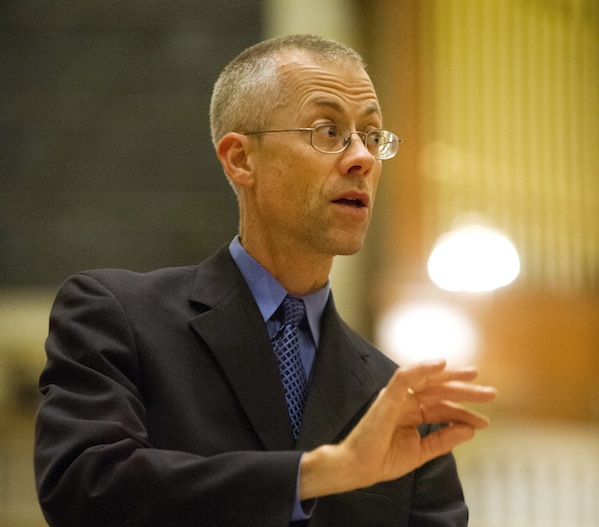Fuse Concert Review: The Calming Artistry of Blue Heron
Simply put, Blue Heron is one of the best perks of concertgoing in 21st-century Boston.
By Susan Miron
Blue Heron, the lavishly praised Renaissance vocal ensemble, began its first season fifteen years ago with selections from the Peterhouse (Cambridge, England) Partbooks. In Weston on October 17 they continued their exploration of the Peterhouse Partbooks with A Mass for St. Augustine of Canterbury. Next spring, the fourth of a five-CD series featuring Jones’s Missa Spes nostra will be released. The final CD of the set will be out sometime in 2016 and it will contain A Mass for St. Augustine of Canterbury. Volume One, released in 2010 to ecstatic reviews, made the Billboard charts; the other two have received equal acclaim. Blue Heron has gone through a number of personnel changes in its decade and a half, but it remains remarkably impressive, a small chorus of accomplished soloists.
In the Early Music haven that Boston has become, many concertgoers know of and have become fans of Blue Heron and its intrepid music director Scott Metcalfe. Still, ask them about the Peterhouse Partbooks, and their eyes may glaze over. But the fact is that Blue Heron’s recording project involving this music is not only of interest to Early Music geeks and nerds. Where was this music the past 460 or so (c. 1540) years, and why has it come to light now? And why does it speak to us with such depth and power?
The program on October 17 will be repeated on Monday, October 20 at Boston University, where the group is in residence. A Mass for St. Augustine of Canterbury is about an hour long, including an intermission. I would have loved to have heard the piece uninterrupted. (But it could well be that, for the sake of the hard-working singers, the respite was a necessity.) There is an ethereal quality to Blue Heron’s voices—and the Renaissance music they bring so splendidly to life—that casts a spell you don’t want broken, if at all possible. For lack of a better word, I would call it a deep and abiding sense of calm.
Besides the obvious (and usual) kudos to Metcalfe, his scholarly program notes, and his singers, a lion’s share of credit for the performance and recording of the Partbooks must go to the British scholar Nick Sandon, who, since the 1980s, has dedicated an impressive amount of sleuth-work to re-creating (perfectly) tenor lines that were missing in the Partbooks. Thus the music can be sung idiomatically, its modern recomposition invisible. That the Partbooks survived at all is a tale of fragile manuscripts beating some very long odds. Singer and scribe John Bull, of Magellan College, Oxford, copied sets of partbooks (now in Peterhouse, Cambridge) from the Henrician (preceding the reign of Henry VIII) before he was to take up a new post at Canterbury Cathedral. He brought, amazingly, some 70 works of virtuosic polyphonic music with him to Oxford. Yet by 1547 Henry VIII died and his son Edward (and other Protestant reformers) took a much dimmer view of this highly sophisticated Latin music. Metcalfe’s program notes explain the music’s fate:
All the elaborate polyphonic music of late medieval English Catholicism became, at best, obsolete. At worst it was viewed as a gaudy ornament to a despicable ritual. Many musical manuscripts were destroyed or lost. By the 1630s they had made their way to the library of Peterhouse, where they would survive yet another cataclysm of destruction, that wrought by the Puritans in the 1640s.
The Mass for St. Augustine of Canterbury is, regrettably, anonymous. A great deal of Metcalfe’s preconcert talk was devoted to an explanation of voice types. If you missed learning about Renaissance vocal music in college, here was your chance to catch up in one easy lesson. Still, with the exception of learning about the detective work of Sandon, I would have appreciated this concert—and all the other Blue Heron concerts I’ve loved—without much background information. Simply put, Blue Heron is one of the best perks of concertgoing in 21st-century Boston. A Mass for St. Augustine of Canterbury shimmered with beauty. (The first three CDs in the series are highly recommended).
Susan Miron, a harpist, has been a book reviewer for over 20 years for a large variety of literary publications and newspapers. Her fields of expertise were East and Central European, Irish, and Israeli literature. Susan covers classical music for The Arts Fuse and The Boston Musical Intelligencer. She is part of the Celtic harp and storytelling duo A Bard’s Feast with renowned storyteller Norah Dooley and, until recently, played the Celtic harp at the Cancer Center at Newton Wellesley Hospital.


